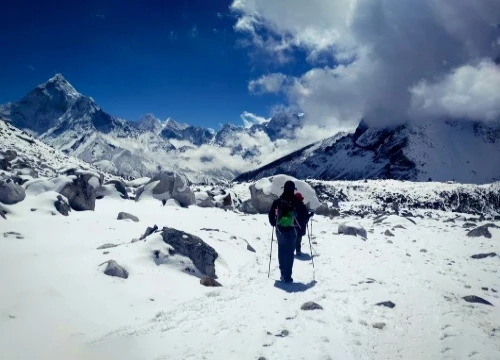The Everest Base Camp trek is renowned not only for its breathtaking landscapes but also for its cultural tapestry woven through centuries of Buddhist traditions. Among the many highlights of this trek are the ancient monasteries where daily rituals provide an intimate glimpse into Sherpa spirituality. In this article, learn about the daily rituals performed at these sacred sites, discover how many major monasteries you’ll encounter along the route, learn their locations, and get approximate trekking times to reach them.
Daily Rituals and Guide to Buddhist Monasteries on the trail of Everest Base Camp Trek
Table of Contents
Daily Rituals in Himalayan Buddhist Monasteries
In the monasteries along the Everest Base Camp trek, daily rituals are an integral part of the monastic lifestyle and community traditions. Here’s what to expect at these spiritual stops:
- Early Morning Puja and Chanting:
As the first rays of sunrise illuminate the Himalayan peaks, monks begin their day with puja (worship ceremonies). They chant mantras, recite sutras, and ring bells or cymbals as a way to purify the atmosphere. These rituals are believed to invoke protection, compassion, and blessings for both the monastic community and trekking visitors. - Butter Lamps and Incense Offerings:
Lighting butter lamps and incense sticks is another common practice. These offerings symbolize the dispelling of darkness and ignorance, and they add a warm, meditative glow to the sacred halls of the monasteries. - Group Meditation and Scripture Reading:
Many monasteries dedicate time for group meditation sessions and the reading of Buddhist texts. This practice not only brings inner peace but also reinforces the rich spiritual heritage of the Sherpa community. - Ritual Blessings for Trekkers:
Occasionally, the monks extend their blessings to passing trekkers by sprinkling holy water or offering friendly nods of respect. This exchange creates a bridge between the spiritual world and the adventure of trekking high in the Himalayas.
These daily activities are more than just routines—they are living traditions that connect trekkers with the ancient cultural fabric of the Everest region .
Major Buddhist Monasteries on the Everest Base Camp Trek
The Everest Base Camp trek is dotted with a number of notable monasteries that serve as both cultural landmarks and spiritual retreats. According to several trekking itineraries, there are approximately nine major monasteries along the route. Here’s a snapshot of these sacred sites and where you can find them:
- Rimishung (Phakding) Monastery:
- Location: Phakding village
- Altitude: Approximately 2,610 meters (8,562 feet)
- Daily Rituals: Early morning puja with chanting and prayer wheel rotations
- Trek Time: Generally reached on the first day from Lukla in about 3–4 hours
- Namche Monastery (Namche Bazaar):
- Location: In Namche Bazaar, the bustling heart of the Khumbu region
- Altitude: Around 3,440 meters (11,286 feet)
- Daily Rituals: Group prayer sessions, meditation, and local blessings
- Trek Time: Typically reached on Day 2, with trekking times of approximately 4–5 hours from Phakding
- Khumjung Monastery (Khumjung Village):
- Location: Khumjung, a traditional Sherpa village
- Altitude: Near 3,790 meters (12,434 feet)
- Daily Rituals: Morning chants and ritual offerings that celebrate local legends
- Trek Time: On a dedicated trekking day from Namche, roughly 3–4 hours
- Thame Monastery (Thame Village):
- Location: Thame, renowned as the birthplace of legendary mountaineer Tenzing Norgay
- Altitude: About 3,740 meters (12,270 feet)
- Daily Rituals: Intimate meditation sessions and meticulous puja ceremonies
- Trek Time: A short detour from Namche or Khumjung, estimated at around 3–4 hours of walking
- Tengboche Monastery (Dawa Choling Gompa):
- Location: Tengboche, a spiritual hub surrounded by panoramic mountain views
- Altitude: Approximately 3,864 meters (12,677 feet)
- Daily Rituals: Sunrise prayers, ritual bell and drum ceremonies, and meditative recitations
- Trek Time: Generally reached in about 3–4 hours from Khumjung or Dingboche
- Pangboche Monastery (Pangboche Village):
- Location: Pangboche village
- Altitude: Around 3,985 meters (13,074 feet)
- Daily Rituals: Encompasses unique local rituals blending ancient traditions with daily devotions
- Trek Time: Reached later in the trek, typically on Day 7, averaging 4–5 hours from Tengboche
- Additional Monasteries:
Other notable sites along or adjacent to the route include monasteries in Ghat village (Pema Choling Monastery), Chheplung (often referred to as the Tiger Nest of Nepal on a rocky cliff), and Deboche Ani Gumba. These contribute to a total of around nine or more key monastic sites that lend the trek its signature cultural depth .
Approximate Trekking Times and Cultural Enrichment
The trekking times mentioned above are approximate and form part of a well-planned itinerary designed to allow for adequate acclimatization. Each monastery visit not only offers spiritual enrichment but also provides trekkers a practical rest day experience amid rigorous mountain hiking. Incorporating stops at these monasteries into your Everest Base Camp trek itinerary gives you the unique opportunity to:
- Slow Down and Absorb Culture: Enjoy reflective pauses and witness authentic Sherpa life.
- Enhance Acclimatization: Use these slower days to rest physically while your body adjusts to increasing altitudes.
- Document an Authentic Experience: Capture stunning visuals of ancient prayer ceremonies against a backdrop of majestic peaks.
Detailed itineraries often include travel durations such as 3–4 hours for early stops (like Phakding) and up to 4–5 hours for higher altitude trails (toward Pangboche), ensuring that each stop is both reachable and blissfully paced for cultural immersion.
Monastery | Location/Altitude | Approx. Trek Time from Previous Stop |
Rimishung (Phakding) | Phakding (≈2,610 m / 8,562 ft) | 3–4 hours from Lukla |
Namche Monastery | Namche Bazaar (≈3,440 m / 11,286 ft) | 4–5 hours from Phakding |
Khumjung Monastery | Khumjung Village (≈3,790 m / 12,434 ft) | 3–4 hours from Namche |
Thame Monastery | Thame Village (≈3,740 m / 12,270 ft) | 3–4 hours from the Namche/Khumjung area |
Tengboche Monastery | Tengboche (≈3,864 m / 12,677 ft) | 3–4 hours from Khumjung or Dingboche |
Pangboche Monastery | Pangboche Village (≈3,985 m / 13,074 ft) | 4–5 hours from Tengboche |
This table not only helps trekkers estimate travel times but also emphasizes the unique blend of physical challenge and spiritual reflection on the Everest Base Camp trek.
Conclusion
The daily rituals in the Buddhist monasteries along the Everest Base Camp trek provide an exceptional insight into Sherpa culture and Himalayan spirituality. From early morning chants and incense offerings at Phakding’s Rimishung Monastery to the panoramic blessings at Tengboche and Pangboche, these sacred sites offer more than a spiritual escape—they serve as a cultural roadmap of the region. With roughly nine major monasteries strategically nestled along the trekking route and accessible through daily trekking legs ranging from 3 to 5 hours, your journey through the Khumbu region becomes a deeply enriching experience.
Whether you’re planning an adventurous Everest Base Camp trek or preparing to explore the sacred monasteries of Nepal for the first time, immersing yourself in these daily rituals will add a profound layer of meaning to your Himalayan odyssey. Explore, engage, and let the ancient chants and timeless traditions guide you through one of the world’s most awe-inspiring landscapes.
Are you eager to dive deeper into other cultural facets of the Everest trek, or do you need more detailed itineraries that combine trekking challenges with spiritual explorations? The journey through Himalayan monasteries is full of hidden gems waiting to be discovered.







